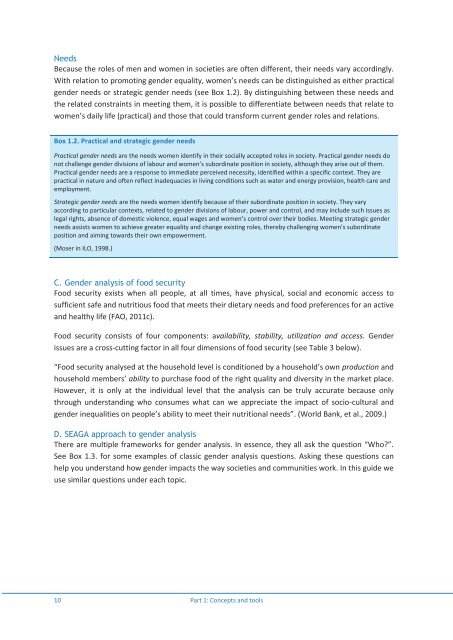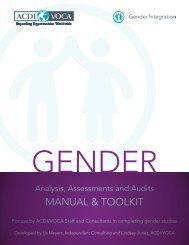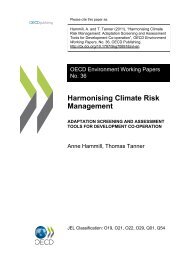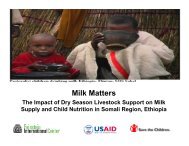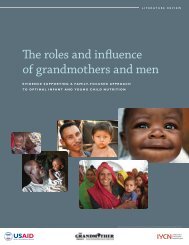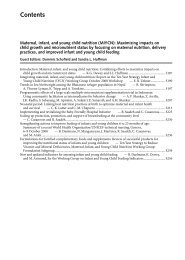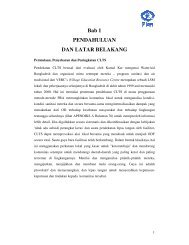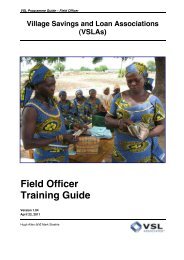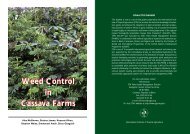Gender and climate change research in - FAO
Gender and climate change research in - FAO
Gender and climate change research in - FAO
Create successful ePaper yourself
Turn your PDF publications into a flip-book with our unique Google optimized e-Paper software.
Needs<br />
Because the roles of men <strong>and</strong> women <strong>in</strong> societies are often different, their needs vary accord<strong>in</strong>gly.<br />
With relation to promot<strong>in</strong>g gender equality, women’s needs can be dist<strong>in</strong>guished as either practical<br />
gender needs or strategic gender needs (see Box 1.2). By dist<strong>in</strong>guish<strong>in</strong>g between these needs <strong>and</strong><br />
the related constra<strong>in</strong>ts <strong>in</strong> meet<strong>in</strong>g them, it is possible to differentiate between needs that relate to<br />
women’s daily life (practical) <strong>and</strong> those that could transform current gender roles <strong>and</strong> relations.<br />
Box 1.2. Practical <strong>and</strong> strategic gender needs<br />
Practical gender needs are the needs women identify <strong>in</strong> their socially accepted roles <strong>in</strong> society. Practical gender needs do<br />
not challenge gender divisions of labour <strong>and</strong> women’s subord<strong>in</strong>ate position <strong>in</strong> society, although they arise out of them.<br />
Practical gender needs are a response to immediate perceived necessity, identified with<strong>in</strong> a specific context. They are<br />
practical <strong>in</strong> nature <strong>and</strong> often reflect <strong>in</strong>adequacies <strong>in</strong> liv<strong>in</strong>g conditions such as water <strong>and</strong> energy provision, health care <strong>and</strong><br />
employment.<br />
Strategic gender needs are the needs women identify because of their subord<strong>in</strong>ate position <strong>in</strong> society. They vary<br />
accord<strong>in</strong>g to particular contexts, related to gender divisions of labour, power <strong>and</strong> control, <strong>and</strong> may <strong>in</strong>clude such issues as<br />
legal rights, absence of domestic violence, equal wages <strong>and</strong> women’s control over their bodies. Meet<strong>in</strong>g strategic gender<br />
needs assists women to achieve greater equality <strong>and</strong> <strong>change</strong> exist<strong>in</strong>g roles, thereby challeng<strong>in</strong>g women’s subord<strong>in</strong>ate<br />
position <strong>and</strong> aim<strong>in</strong>g towards their own empowerment.<br />
(Moser <strong>in</strong> ILO, 1998.)<br />
C. <strong>Gender</strong> analysis of food security<br />
Food security exists when all people, at all times, have physical, social <strong>and</strong> economic access to<br />
sufficient safe <strong>and</strong> nutritious food that meets their dietary needs <strong>and</strong> food preferences for an active<br />
<strong>and</strong> healthy life (<strong>FAO</strong>, 2011c).<br />
Food security consists of four components: availability, stability, utilization <strong>and</strong> access. <strong>Gender</strong><br />
issues are a cross-cutt<strong>in</strong>g factor <strong>in</strong> all four dimensions of food security (see Table 3 below).<br />
“Food security analysed at the household level is conditioned by a household’s own production <strong>and</strong><br />
household members’ ability to purchase food of the right quality <strong>and</strong> diversity <strong>in</strong> the market place.<br />
However, it is only at the <strong>in</strong>dividual level that the analysis can be truly accurate because only<br />
through underst<strong>and</strong><strong>in</strong>g who consumes what can we appreciate the impact of socio-cultural <strong>and</strong><br />
gender <strong>in</strong>equalities on people’s ability to meet their nutritional needs”. (World Bank, et al., 2009.)<br />
D. SEAGA approach to gender analysis<br />
There are multiple frameworks for gender analysis. In essence, they all ask the question “Who”.<br />
See Box 1.3. for some examples of classic gender analysis questions. Ask<strong>in</strong>g these questions can<br />
help you underst<strong>and</strong> how gender impacts the way societies <strong>and</strong> communities work. In this guide we<br />
use similar questions under each topic.<br />
10 Part 1: Concepts <strong>and</strong> tools


